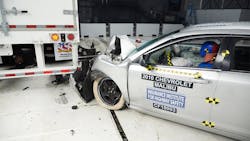The National Highway Traffic Safety Administration’s upgrade to rear impact guard standards appears to be “out of sync” with the U.S. Dept. of Transportation’s broader safety goals, or so the Insurance Institute for Highway Safety contends.
Specifically, in a statement published shortly after NHTSA announced the new rule June 30, IIHS refers to Safe System, DOT’s recently adopted framework that aims to mitigate risk on American highways. The “holistic” Safe System is designed around “multiple layers of protection” to prevent crashes and minimize the harm caused to those involved when crashes do occur.
“We were pleased to see DOT adopt this strategy, but we also knew those were just words on paper,” IIHS President David Harkey said. “Success requires implementation of redundant safety interventions like better underride protection on trailers to ensure that a mistake on the roadway does not result in serious injury or death.
“NHTSA’s updated rule does not go far enough to be meaningful.”
IIHS has pushed for stronger government regulations to improve rear underride guards on large trucks for nearly 50 years, Harkey noted. While an updated standard went into effect in 1998, IIHS judged it be “too weak.”
IIHS research in the early 2000s "confirmed that assessment." Based on their research and crash testing, IIHS petitioned the federal government in 2011 to improve underride protection. NHTSA initiated the rulemaking that led to the new standards in 2015.
“The final rule issued by NHTSA falls well short of addressing most of the concerns raised in our petition. While the new standard is an improvement over the old one, nearly all newly manufactured guards on trailers already meet this new standard,” Harkey said. “To truly reduce the number of lives lost in underride crashes, NHTSA needs to incorporate changes that would require crash testing of guards when mounted on trailers, allow fewer exemptions for other kinds of trucks and improve protection in offset crashes. The Safe System strategy, if it is to be more than words on paper, requires NHTSA to take all these steps.”
IIHS crash testing and the TOUGHGUARD standards the organization introduced in 2017 have prompted several of the largest trailer manufacturers to strengthen their underride guards well beyond the federal minimums, “demonstrating that further improvements are feasible,” Harkey added.
The IIHS position echoes that of other highway safety organizations, while trailer manufacturers emphasize the importance of the rulemaking process and their willingness to continue to work with NHTSA on future standards.
About the Author
Kevin Jones
Editor
Kevin has served as editor-in-chief of Trailer/Body Builders magazine since 2017—just the third editor in the magazine’s 60 years. He is also editorial director for Endeavor Business Media’s Commercial Vehicle group, which includes FleetOwner, Bulk Transporter, Refrigerated Transporter, American Trucker, and Fleet Maintenance magazines and websites.
Working from Beaufort, S.C., Kevin has covered trucking and manufacturing for nearly 20 years. His writing and commentary about the trucking industry and, previously, business and government, has been recognized with numerous state, regional, and national journalism awards.

